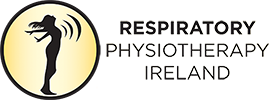Active Cycle of Breathing Technique is a breathing exercise.
Aim:
- To increase lung expansion
- To clear secretions from the lungs.
Coughing alone can be tiring and ineffective. The ACBT uses different types of breaths to make it easier to clear secretions by moving secretions from the small airways at the bottom of the lungs to larger airways near the top where they can be cleared more easily with huffing/coughing.
It is important that you are in a comfortable position with shoulders relaxed. Upright sitting and side lying are recommended. The physiotherapist will advise you on the most appropriate position for you.
Active Cycle of Breathing should only be carried out following demonstration and instruction by your physiotherapist.

Active Cycle of Breathing Technique consists of 4 Steps:
Step A: Relaxed Breathing / Breathing Control
This is normal, gentle breathing using the lower chest to allow you to relax
- Rest one hand on your abdomen so that you can feel it rise and fall with your breathing.
- Breathe in gently feeling your hand rise and your lower chest expand.
- Breathe out gently allowing your shoulders to relax down. The breath out should be slow, like a “sigh”.
Step B: Deep Breathing (Thoracic Expansion)
This gets air right down to the bottom of the lungs where it can loosen secretions.
- Breath in deeply feeling your lower chest expand as far as possible. The breath in should be nice and slow. Try to keep your neck and shoulders relaxed.
- Hold the breath for up to three seconds.
- Let the air out gently.
- Repeat this step x 4 – 5times.
Step C Huff (Forced expiratory technique)
This is a short sharp breath out through an open mouth that helps to force the secretions out.
To perform this, imagine you are trying to fog up a glass or mirror.
Remember the huff needs to be through an open mouth, using your abdominals muscles. Repeat the huff if necessary to mobilise/clear secretions. It may stimulate a cough.
Cough
This allows you to get the secretions up and out of your mouth. Only Cough if you feel the secretions are ready to be cleared as coughs can be tiring.
Note: If this technique is used following surgery, a supported cough can be performed using a pillow. The pillow can be held over the scar site to ease pressure on the wound, reduce pain whilst coughing making the cough more effective.
Frequency and Duration
Your respiratory physiotherapist will advise you on how often and how long you should perform the Active Cycle of Breathing Technique. If you spit up secretions every day then you will need to clear your lungs daily.
Benefits of active cycle of breathing technique
- Removing excess secretions helps reduce risk of chest infections
- Prevents/treats atelectasis (collapse or closure of part or all of the lung)
- Improve lung volume and therefore function.
- Improves gas exchange (delivery of oxygen from the lungs to the bloodstream and the elimination of carbon dioxide from the bloodstream to the lungs)
- Once taught it can be carried out independently without supervision from your physiotherapist
- Easy Technique
- No equipment required
- Can be modified to be used by most patients
- Using these exercises will help clear lungs effectively without tiring you as it minimises the amount of coughing required.
Other things which may help
- If using a prescribed bronchodilator/inhaler, take the medication before performing these exercises as instructed by your physiotherapist
- Your physiotherapist will advise you if your nebulizied medication is to be inhaled prior to or during the AD session or after the lungs have been cleared.
- Drinking plenty of clear water may help loosen secretions
- Clear your chest before you eat
- If your secretions changes colour, take a sample to your doctor
- Extra sessions of these breathing exercises may be required during an exacerbation of your condition.
- If you have any questions about your chest condition, contact your doctor, nurse or physiotherapist.
